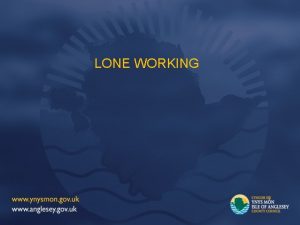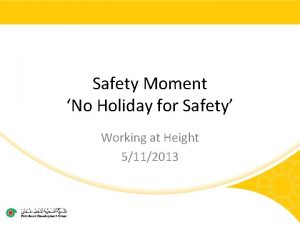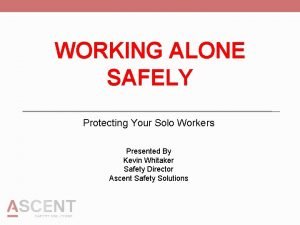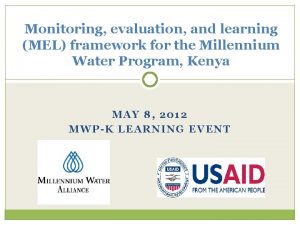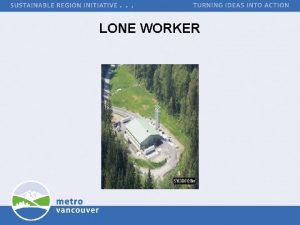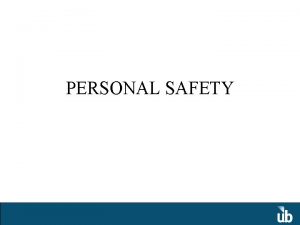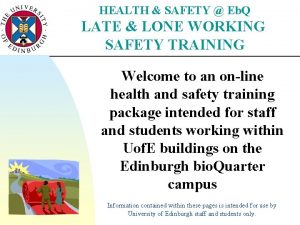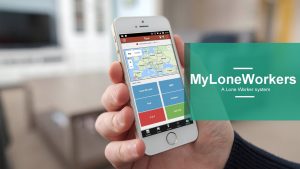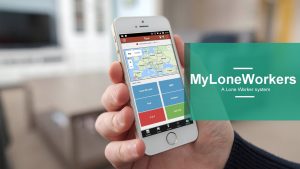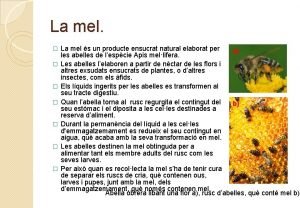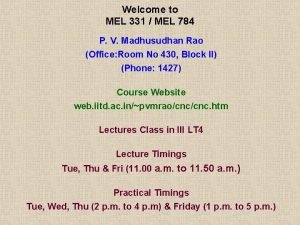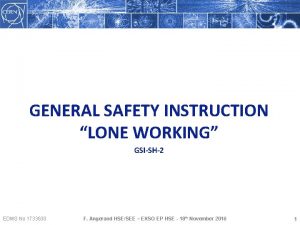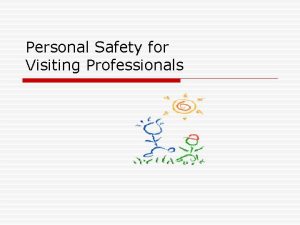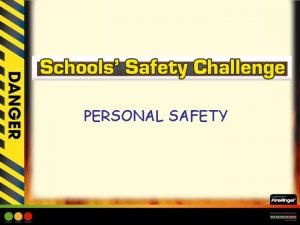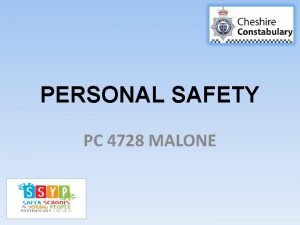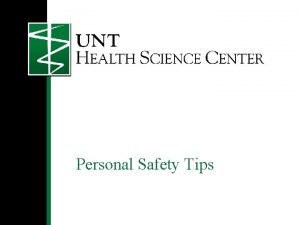Personal safety lone working Mel Connelly Regional Head























- Slides: 23

Personal safety & lone working Mel Connelly Regional Head – Central Region BBC Children in Need

What today will cover: • Employers’ and employees responsibilities • Personal Safety Policies • Risks – the factors that should be considered when thinking about personal safety • Measures to promote personal safety • Information about technology available to support personal safety

What is Personal Safety?

What is Personal Safety? An individual’s freedom from risk, danger or harm caused by the behaviour of others

Whose responsibility? 1. Be aware of risk assessments & report issues not covered 2. Have a right to be protected at work 8. Report incidents of violence & aggression as well as ‘causes for concern’ 3. Provide policies & procedures that 5. Learn from incidents and make changes assist in the management of personal where necessary safety 7. Make choices about what are reasonable measures to take to control risks 4. Provide an accessible 6. Provide support to individuals reporting system & learn from when incidences occur reports made 9. Do not put self or others in danger

Organisational Responsibilities • Provide an accessible reporting system and learn from reports made • Set the ethos and provide a framework for managing personal safety • Learn from incidents and make changes where necessary • Provide policies & procedures that assist in the management of personal safety • Complete risk assessments on key tasks that people carry out • Provide support to individuals when incidents occur • Make choices about what are reasonable measures to take to control risk • Provide training and communicate how Personal Safety is managed

Personal Responsibilities • Learn from incidents and make changes where necessary • Do not put self or others in danger • Follow procedures that have been devised to safeguard personal safety • Be aware of risk assessments and report issues not covered • Have a right to be protected at work • Attend and take part in training, read information about how Personal Safety is being managed • Use reasonable force only when necessary • Report incidents of violence and aggression as well as ‘causes for concern’

What the law requires • Requires employers to be ‘safe’ • There is a clear dual responsibility – Employers have a duty of care – Employees have a duty of care

Cost to Organisation - Case law. Ingram v Hereford and Worcester County Council (2000) Mr Ingram had to endure both physical and verbal abuse from those he encountered on a number of travellers’ sites managed by the council. This included having a dog set on him and being shot at. The case was based on the employers alleged breach of duty of care in that it failed to provide Mr Ingram with a safe system of work, resulting in him suffering prolonged and unremitting stress. He eventually received a record settlement of £ 203, 000

Cost to Organisation – Financial. The Corporate Manslaughter Act makes it possible for employers to be prosecuted if someone has been killed at (or by) work because of a failure in how the organisation's activities are managed or organised, amounting to a 'gross breach of duty'. If an organisation is deemed to be responsible, then a maximum fine of 10% of their income can be applied.

Cost to Organisation – Name & Shame Guilty organisations will be ordered to take remedial measures to ensure they put in place adequate safety systems and procedures. This may include face a publicity order requiring them to make public what went wrong and what is being done to repair the situation. This could mean organisations having to take out an advert in national newspapers. There's an element of name and shame and culpable organisations may experience huge damage to their brand reputation.

Personal Safety Anticipate and recognise a risk and take action to: • Avoid it • Reduce it • Monitor/manage it

Assessing the risks • People • Environment • Task

Scenario Miss A, a twenty-two year-old nurse, works at a large teaching hospital. She is on night duty and should leave for work at 10 pm to get to hospital in time to start work at 11 pm. She is late and leaves for work at 10: 20 pm. She is in uniform, carrying a briefcase and a shopping bag in one hand a handbag in the other. She takes a shortcut through an enclosed park and suddenly, apparently from nowhere, a man attacks her. He drags her behind some bushes, threatening her and saying, ‘I’ve got a knife – scream and I’ll kill you!’ 1. What could she have done before leaving home 2. What could she have done whilst walking to work? 3. What could she have done at the time of the attack?

The Choices Triangle Choice A Model of Personal Safety Time

P. L. A. N for your Personal Safety Prepare Look confident Act to avoid risk and danger Never assume it won’t happen to you

Exercise • In groups work through the case studies provided, thinking about the following: – – What actions could the person have taken beforehand? What actions could the person take during? What could they do now? What could their colleagues do beforehand now?

Working alone or from home Insurance Set up regular points of contact with others Make others aware of your movements Do you have to meet people in your own home, or alone in your office? can you meet in public places instead? • If your work involves meeting clients in their own homes, consider subscribing to an organisation that can track your whereabouts • •

Telephone abuse • • • Listen – don’t interrupt Let them blow off steam When you respond, refer to them by name Acknowledge their feelings State your position If the abuse continues, or if they are being particularly abusive, you have the right to hang up@ 1. 2. 3. • Warn the caller that if the behaviour continues you will hang up If the behaviour does continue then remind the caller of what you have said previously and hang up You should report the incident in line with your violent incident and reporting procedures Any threats against your person are considered a criminal act. You must report such incidents to your manager/organisation

Personal Safety policy • If your organisation doesn’t have a Personal Safety policy, can you raise it with them? • Give some thought to the processes you think should be in place for staff attending visits and meetings to ensure their personal safety is promoted • Who should it involve in the organisation? • Personal Safety champions? • Can a working group be put together to input into the development of a policy?

Lone Worker - technology • • There are many different technologies out there that can help support personal safety – for example: Sky. Guard, My. Team. Safe, Lone Alert, Alert-a-buddy, Blackline Safety, Call Handling, Communicare, Crystal Ball, Guardian 24, Lookout Call, Lone Worker Solutions, People Safe, Reliance Protect, Soloprotect, Staysafe, Trackplot As an example, Children in Need uses the ‘Text You Home’ system to provide an additional safety measure for lone workers attending meetings outside of the office – is relatively simple to use, (ts important that an employer identifies the right solution for their specific working arrangements – this system may not be appropriate for everyone): – Staff identify 6 work contacts who should be contacted in the event of an alarm going off – Staff set their alarms based on when they are due to end a visit or a meeting – If they do not cancel the alarm, then an alarm is raised to the first contact and quickly cascaded to the other 5 – We then have a cascade process for dealing with an alarm. – Staff put details of their whereabouts in their calendars which are shared across the organisation – If the visit/meeting is outside of office hours, then they flag up the visit with their first main contact beforehand. – There is also a panic button facility, which will raise an immediate alarm

Any questions?

Thank you – and stay safe!
 Connelly barnes
Connelly barnes Lone working meaning
Lone working meaning Personal safety vs process safety
Personal safety vs process safety Regional write up head face and neck
Regional write up head face and neck Hard work or smart work
Hard work or smart work Hot working and cold working
Hot working and cold working Hot working and cold working difference
Hot working and cold working difference Machining operations
Machining operations Contoh hot working
Contoh hot working Dividing head parts
Dividing head parts The attacking firm goes head-to-head with its competitor.
The attacking firm goes head-to-head with its competitor. Html teksta noformēšana
Html teksta noformēšana The head of a moving head disk
The head of a moving head disk Chest parts
Chest parts What is the tonic syllable
What is the tonic syllable Suction lift
Suction lift Condyles of femur
Condyles of femur The tone unit
The tone unit The head of moving head disk with 100 tracks
The head of moving head disk with 100 tracks Safety moment slide
Safety moment slide Safety tips for working alone
Safety tips for working alone Petr měl obdélník šířky 2 cm a neznámé délky
Petr měl obdélník šířky 2 cm a neznámé délky Mel activities
Mel activities Melcon examples
Melcon examples

